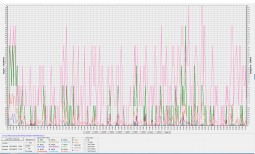In an earlier article, I mentioned that the RTL2832u / E4000 does a pretty reputable job receiving ADS-B signals. I thought it would be interesting to see just how well it worked. I used a couple of Windows tools to analyze the data decoded by gr-air-modes from the RTL2832u stick. The first tool is SBSPlotter, which creates a polar map showing the range and direction of the ADS-B signals you are receiving. This is a nice little tool to help you tweak your antenna or antenna placement for the best performance. SBSPlotter can be downloaded from http://jetvision.de/sbs.shtml. The second tool was BSTChart, that will plot the type of ADS=B messages and number of messages from your receiver. BSTChart can be downloaded here. These programs work fine with gr-air-modes since the server outputs the ADS-B messages in Kinetics SBS-1 format. You just need to give them the IP address and port 30003 of the machine running the gr-air-modes and the RTL2832u server. They may work under Wine on your Linux box, but I did not try it. I just routed the data from my Linux box to a PC.
Now, what makes this interesting, is that these tests where done on the stock antenna inside. Not only was the antenna inside, it was sitting on mywork desk surrounded by plenty of metal objects. I don’t think the little stock antenna does much since you can unscrew it and still get signals. I ran

both programs for about 5 hours or so collecting data. Even without a good outside antenna, SBSPlotter shows that I am able to receive ADS-B signals about 60 – 70nm away. You can also see that most of the signals are coming from the North to North West, which is correct for my area. Taking a look at the BSTChart plots, you will see that the RTL2832u receives a fairly large number of ADS-B messages. However, if we filter the chart down a bit, you will see that the messages for altitude and direction are fewer. This is not terribly unusual for aircraft operating in the US.
What this does show is that for $25, the RTL2832u / E4000 makes a fairly decent ADS-B receiver. It will be interesting to add a better antenna cut for 1090MHz eventually and see if there is much improvement. I am sure just getting the antenna outside in the clear would be a big improvement. I imagine that the RTL2832u doesn’t perform as well as a receiver specifically designed for 1090MHz, but at $25


On a related note, I understand that it is getting harder to find dongles with the RTL2832u dongles including the E4000 chipset. There as been some discussion that chipsets with the RTL2832u and R820T may be a good potential replacement. There are some possible advantages like no center spike, better sensitivity, and lower cost (around $10). I have one on order and will checking it out when it comes in.
In the meantime discuss the article in our ADS-B forum.